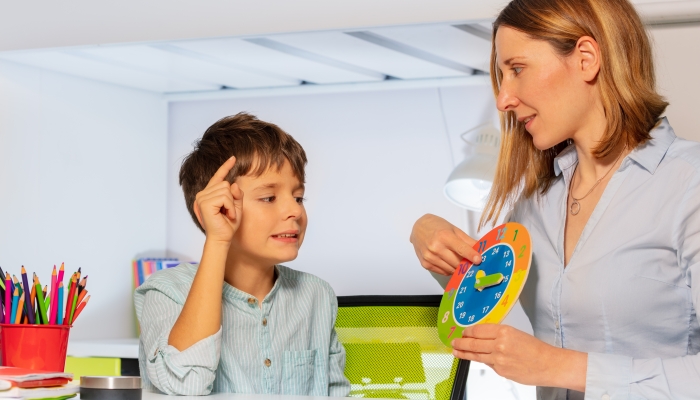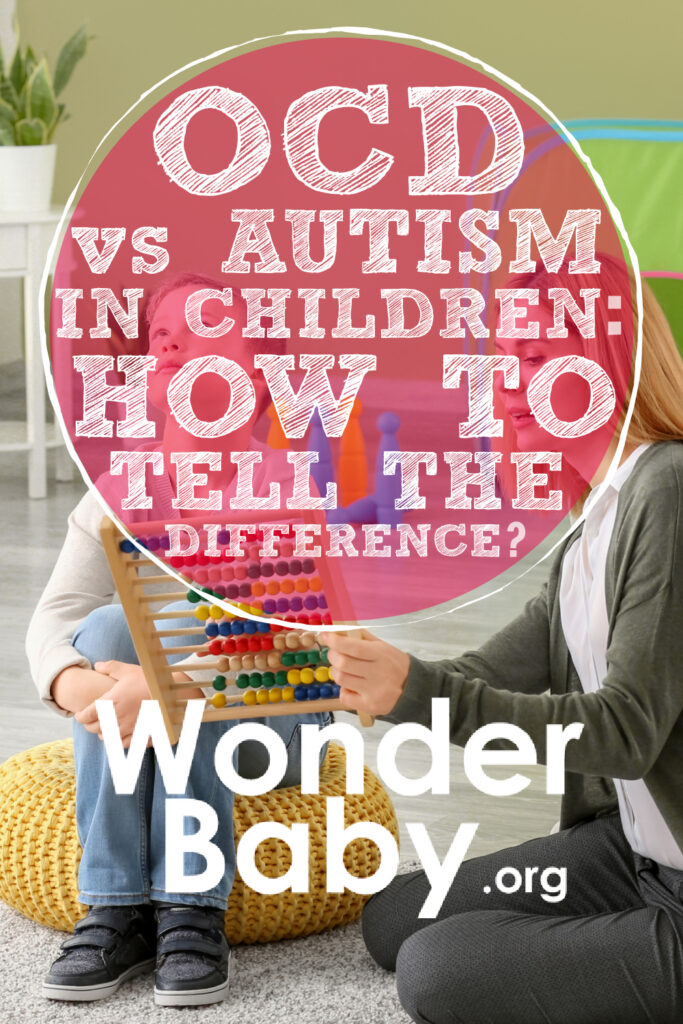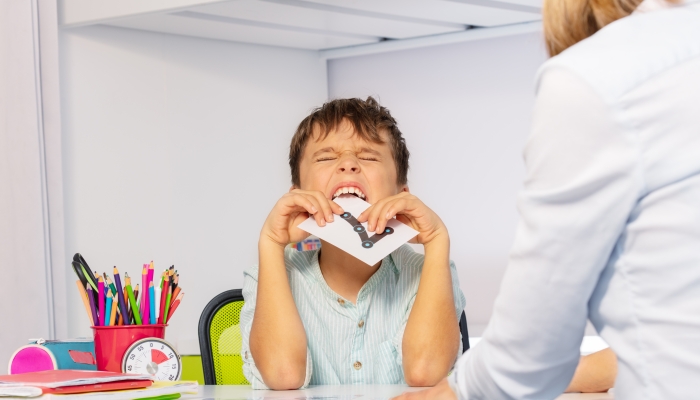OCD vs Autism in Children: How To Tell the Difference

- OCD and ASD are fundamentally different, but their symptoms are very similar.
- Both OCD and ASD involve repetitive behaviors, but the reason a child performs the behavior is usually different.
- A thorough assessment by a professional will help to ensure your child gets an accurate diagnosis.
- Family involvement in treatment will help reduce inadvertently contributing to repetitive behaviors.
If your child with ASD has started a new repetitive behavior, you might begin to question if he also has OCD.
For example, maybe your child has started excessively washing his hands with lots of bubbles.
Your child might be obsessing over germs and is now washing his hands repeatedly to try and ensure he is clean, which could indicate an OCD diagnosis. Or your child might enjoy the sensation of bubbles on his hands and routinely seek sensory input with the bubbles, a behavior associated with ASD.
Obsessive-compulsive disorder (OCD) and autism spectrum disorder (ASD) can look so similar that they are often misdiagnosed. Although both disorders have unique symptoms, several symptoms overlap. Understanding the differences in OCD vs autism can help you best understand your child’s needs.
Comparing OCD and Autism

Although OCD and autism are fundamentally different, their symptoms are very similar. Professionals can help ensure your child gets the correct diagnosis; however, understanding the differences and symptoms can help you best support your child.
Overlapping Symptoms
OCD and ASD both involve restricted, repetitive behaviors. Restricted, repetitive behaviors occur frequently in a manner that is inappropriate or odd to the situation. These might be called obsessions, compulsions, restricted interests, or repetitive behaviors. A systemic review in 202411. O’Loghlen, J., McKenzie, M., Lang, C., & Paynter, J.. Repetitive Behaviors in Autism and Obsessive-Compulsive Disorder: A Systematic Review. Journal of Autism and Developmental Disorders. 2024. https://doi.org/10.1007/s10803-024-06357-8 of repetitive behaviors in autism and OCD discusses how these behaviors can overlap between OCD and ASD, making it hard sometimes to diagnose correctly.
Children diagnosed with OCD have obsessions and/or compulsions. These repetitive thoughts or behaviors are done to try and reduce anxiety. Anxiety is also present in ASD. However, not all repetitive behaviors related to ASD are done to reduce anxiety. Although typical for both disorders, anxiety is significantly more prevalent in OCD.
Children with ASD or OCD have a preference for sameness and difficulty adjusting to change. Change can increase anxiety, and children may become rigid with routines to try and prevent change from occurring.
Behavioral Differences
ASD is a developmental and neurological disorder, while OCD is a mental health disorder. Although some symptoms appear very similar, there are some key differences.
While both OCD and ASD involve repetitive behaviors, the reason a child performs the behavior is usually different. In OCD, a child’s behaviors come from a place of fear and anxiety. Unwanted obsessions cause anxiety, and compulsions are done to alleviate that anxiety. In OCD, anxiety is significantly more prevalent than it is in ASD.
In ASD, repetitive behaviors are more comfort-driven. They are rarely used as a tool to reduce anxiety but are more often repeated for comfort. They are sensory-seeking or avoiding behaviors that can be enjoyable for the child. Sometimes, these repetitive behaviors come from a place of passionate interest.
These passionate interests and behavioral problems in ASD can contribute to social interaction difficulties. Repetitive behaviors and interests can become so time-consuming and intense that they can push other children away. In addition, children with ASD have more severe problems with social interactions than children with OCD.
Children with OCD might have difficulty understanding social cues, especially facial emotions. In contrast, children with ASD have a more challenging time understanding nonverbal and social cues in addition to facial expressions. Children with ASD might prefer slower-paced conversations and avoid small talk.
Neurological Differences
In OCD, repetitive behaviors are a response to intrusive thoughts and are used to try and reduce anxiety. Children can’t substitute these specific repetitive behaviors. Brain imaging conducted in a 2017 study22. Carlisi, C. O., Norman, L., Murphy, C. M., Christakou, A., Chantiluke, K., Giampietro, V., Simmons, A., Brammer, M., Murphy, D. G., Mataix-Cols, D., & Rubia, K.. Disorder-Specific and Shared Brain Abnormalities During Vigilance in Autism and Obsessive-Compulsive Disorder. Biological Psychiatry: Cognitive Neuroscience and Neuroimaging. 2017;2(8), 644–654. https://doi.org/10.1016/j.bpsc.2016.12.005 indicates differences neurologically for OCD and ASD. Brain imaging in individuals with OCD shows smaller prefrontal regions and larger striatum regions.
When repetitive behaviors are done to soothe, as in ASD, children might choose from various behaviors. Brain imaging of children with ASD shows reduced connectivity between different regions of the brain.
Co-occurrence of OCD and Autism
Although there are differences, both of these disorders can exist simultaneously. A child can have both ASD and OCD. If a child with ASD has symptoms of anxiety disorder, they often meet the criteria for OCD. When a child has both OCD and ASD, it can be challenging to diagnose because symptoms may present differently.
In addition, treatments for OCD and ASD are different. It can be challenging to utilize the best treatment modality if ASD and OCD are co-occurring.
Understanding OCD (Obsessive-Compulsive Disorder)

Obsessive-compulsive disorder (OCD) is a mental health disorder. OCD is characterized by obsessions and/or compulsions that interfere with daily living. Children may have only obsessions, compulsions, or both.
Obsessions
Obsessions are persistent and unwanted thoughts or images. They are often fear-based, unpleasant, and unwanted. These unwanted thoughts and feelings cause anxiety and distress in most individuals. Children might describe feeling stuck on something because it doesn’t “feel just right.”
Examples of obsessions include:
- Fear of germs
- Fear of contamination
- Need for symmetry
- Preoccupation with organization
- Doubt of completion of specific actions
- Taboo thoughts
- Fears of harm to oneself or others
Children will try to ignore these obsessions or reduce them with another thought or action, like performing a compulsion.
Compulsions
Compulsions are repetitive behaviors that are performed excessively to reduce anxiety from obsessions. Children with OCD believe that performing these behaviors will help them feel better or prevent bad things from happening. Usually, compulsions are not tied to actual danger or something bad happening, or the compulsion is extreme.
Examples include:
- Excessive hand washing
- Arranging objects
- Checking that a task has been completed multiple times
- Hoarding
- Counting
- Repeating words silently
Compulsions are not done for pleasure but may cause relief.
Diagnosing OCD in Children
OCD is diagnosed by a mental health professional utilizing a comprehensive assessment. This assessment includes extensive interviews with parents and the child and structured measurement questionnaires.
To be diagnosed with OCD, children must meet the criteria established in the Diagnostic and Statistical Manual of Mental Disorders (DSM-V-TR).
This includes the presence of obsessions, compulsions, or both. These obsessions and/or compulsions must be time-consuming or cause significant distress or impairment. Compulsions are more easily diagnosed for children than obsessions since compulsions are observable behaviors.
Most individuals have occasional intrusive thoughts, like worrying about locking the door and checking it twice before leaving. But unless those obsessions or compulsions become time-consuming or cause significant distress, it’s not OCD.
OCD can run in families and has a biological and genetic component. According to the DSM-5-TR, OCD is two to 10 times more likely if a first-degree relative has OCD. It is also noted that physical or sexual abuse or other stressful or traumatic events can increase the likelihood of an OCD diagnosis later on.
Understanding Autism Spectrum Disorder (ASD)

Autism spectrum disorder (ASD) is a developmental and neurological disorder characterized by social and communicative impairments and repetitive behaviors.
ASD has an onset during the developmental period and is a lifelong disorder. ASD is most commonly diagnosed at age 3, but certain cognitive and behavioral deficits can be diagnosed as early as 18–24 months. ASD is considered a spectrum disorder because of the variability and intensity of the different symptoms.
Symptoms of Autism in Children
Children with ASD have difficulty with communication and understanding social cues. This can create social challenges for children.
Some signs of social challenges include:
- Not responding to their name
- Avoiding eye contact
- Not smiling when you smile at them
- Not talking as much as their peers
- Repeating phrases or unusual speech
- Difficulty understanding what others think or feel
- Struggling to make friends or preferring to be alone
Children with ASD have repetitive behaviors that are different from OCD compulsions. These behaviors come from a place of passionate interest, can be enjoyable, and bring comfort. These behaviors may also be sensory-motor behaviors.
Some behaviors are a response to an abnormal reaction to sensory stimuli. Your child might have an under or overreaction to specific stimuli. A child with ASD cannot regulate sensory reactions and starts repetitive sensory-motor behaviors to help restore sensory balance.
Examples include:
- Hand flapping
- Flicking fingers
- Spinning objects
- Rocking
You might notice your child focusing his attention on stimuli for very long periods. This “sticky attention” can be seen very early on and can be an indicator of ASD. They might be restricted or preoccupied with particular objects or topics, like trains or presidents. Typically this obsession is very specific and abnormal in intensity.
A child might also insist on sameness behaviors. You will see ritualistic habits and strict adherence to well-established routines. Children will appear inflexible and dysregulated when routines change.
Diagnosing Autism in Children
Symptoms of ASD can present as early as 18–24 months. However, most children are diagnosed around age 3. If your child has several of the common symptoms of ASD, talk with your pediatrician for a referral for an autism assessment. Early intervention is crucial so you can learn the best resources and tools to support your child’s needs.
An autism assessment involves observations, interviews, and standardized assessment tools completed by a professional specializing in ASD. A team of professionals will interview parents, friends, family, teachers, doctors, and others involved in your child’s life. They will complete thorough observations of your child interacting and playing while also completing specific standardized assessments.
Treatment and Support Strategies

Treatment for OCD and autism can differ even if the symptoms are often similar. This can include therapy, medications, or a combination of both.
Treatment for OCD
The most common treatment modality for OCD is cognitive-behavioral therapy (CBT). The goal of therapy for your child with OCD will involve teaching your child about symptoms and coping strategies. A therapist can help your child become aware of their obsessive thoughts and behaviors.
Other treatments might include therapies similar to exposure and response prevention. This therapy involves gradual steps to face the problem without engaging in compulsive behavior with the support of a therapist.
The family needs to be a part of the treatment process. Talk with your child’s treatment team to learn how to respond in a supportive manner without accidentally making obsessions or compulsions more likely to happen again.
For some children, medication is sometimes recommended. Discuss this with your child’s pediatrician and treatment team.
Treatment for Autism
Early diagnosis will enable your child with autism to get more support. When a formal diagnosis for ASD is given, specifiers are included to share your child’s specific needs. This will help your child’s treatment team create an individualized treatment plan. This will also help you understand your child better and can help with parenting and how to discipline and support your child.
Your child’s treatment team might include doctors, specific therapists, and school professionals. Treatment will focus on a combination of developmental and behavioral approaches and might consist of:
- Speech and language therapy
- Behavioral therapy
- Occupational therapy
- Educational therapy
- Physical therapy
- Medication
Strategies for Co-occurrence
Treating OCD and ASD together can be challenging. The standard treatments for OCD, like CBT, are not as effective for children with ASD. A parent’s involvement in treatment, specifically the psychoeducation piece of CBT, can help reduce inadvertently contributing to OCD.
Focusing on a tailored approach for those with both conditions is essential. Ensure that your child’s care team professionals specialize in OCD and ASD and coordinate with them.
References
- O’Loghlen, J., McKenzie, M., Lang, C., & Paynter, J. (2024). Repetitive Behaviors in Autism and Obsessive-Compulsive Disorder: A Systematic Review. Journal of Autism and Developmental Disorders. https://doi.org/10.1007/s10803-024-06357-8
- Carlisi, C. O., Norman, L., Murphy, C. M., Christakou, A., Chantiluke, K., Giampietro, V., Simmons, A., Brammer, M., Murphy, D. G., Mataix-Cols, D., & Rubia, K. (2017). Disorder-Specific and Shared Brain Abnormalities During Vigilance in Autism and Obsessive-Compulsive Disorder. Biological Psychiatry: Cognitive Neuroscience and Neuroimaging, 2(8), 644–654. https://doi.org/10.1016/j.bpsc.2016.12.005

Related Posts

Autism
Developing Time Management Skills in Children with Autism: 7 Tips
Learn how you can use structure and visual aids to help your child with autism learn time management skills.

Autism
Occupational Therapy for Children with Autism: How It Can Make a Difference
Children with autism face challenges in many different areas. Occupational therapy can help children address these difficulties while having fun!

Behavior
Understanding Intermittent Explosive Disorder in Children
Are you worried about your child’s unexpected aggression and explosive behaviors? Learn how to support a child with intermittent explosive disorder.